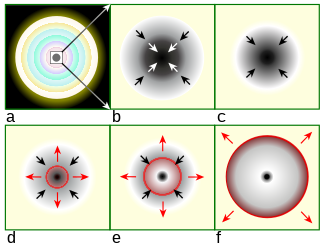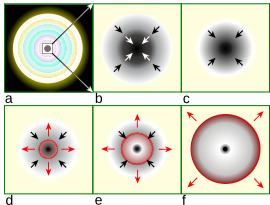
A black hole is a region of spacetime where gravity is so strong that nothing, including light and other electromagnetic waves, is capable of possessing enough energy to escape it. Einstein's theory of general relativity predicts that a sufficiently compact mass can deform spacetime to form a black hole. The boundary of no escape is called the event horizon. A black hole has a great effect on the fate and circumstances of an object crossing it, but it has no locally detectable features according to general relativity. In many ways, a black hole acts like an ideal black body, as it reflects no light. Quantum field theory in curved spacetime predicts that event horizons emit Hawking radiation, with the same spectrum as a black body of a temperature inversely proportional to its mass. This temperature is of the order of billionths of a kelvin for stellar black holes, making it essentially impossible to observe directly.
The Chandrasekhar limit is the maximum mass of a stable white dwarf star. The currently accepted value of the Chandrasekhar limit is about 1.4 M☉ (2.765×1030 kg). The limit was named after Subrahmanyan Chandrasekhar.

A neutron star is a collapsed core of a massive supergiant star. The stars that later collapse into neutron stars have a total mass of between 10 and 25 solar masses (M☉), possibly more if the star was especially rich in elements heavier than hydrogen and helium. Except for black holes, neutron stars are the smallest and densest known class of stellar objects. Neutron stars have a radius on the order of 10 kilometers (6 mi) and a mass of about 1.4 M☉. They result from the supernova explosion of a massive star, combined with gravitational collapse, that compresses the core past white dwarf star density to that of atomic nuclei.

Stellar evolution is the process by which a star changes over the course of time. Depending on the mass of the star, its lifetime can range from a few million years for the most massive to trillions of years for the least massive, which is considerably longer than the current age of the universe. The table shows the lifetimes of stars as a function of their masses. All stars are formed from collapsing clouds of gas and dust, often called nebulae or molecular clouds. Over the course of millions of years, these protostars settle down into a state of equilibrium, becoming what is known as a main-sequence star.
The following is a timeline of gravitational physics and general relativity.
Degenerate matter occurs when the Pauli exclusion principle significantly alters a state of matter at low temperature. The term is used in astrophysics to refer to dense stellar objects such as white dwarfs and neutron stars, where thermal pressure alone is not enough to avoid gravitational collapse. The term also applies to metals in the Fermi gas approximation.
A MAssive Compact Halo Object (MACHO) is a kind of astronomical body that might explain the apparent presence of dark matter in galaxy halos. A MACHO is a body that emits little or no radiation and drifts through interstellar space unassociated with any planetary system. Since MACHOs are not luminous, they are hard to detect. MACHO candidates include black holes or neutron stars as well as brown dwarfs and unassociated planets. White dwarfs and very faint red dwarfs have also been proposed as candidate MACHOs. The term was coined by astrophysicist Kim Griest.
In astronomy, the term compact object refers collectively to white dwarfs, neutron stars, and black holes. It could also include exotic stars if such hypothetical, dense bodies are confirmed to exist. All compact objects have a high mass relative to their radius, giving them a very high density, compared to ordinary atomic matter.

A stellar black hole is a black hole formed by the gravitational collapse of a star. They have masses ranging from about 5 to several tens of solar masses. They are the remnants of supernova explosions, which may be observed as a type of gamma ray burst. These black holes are also referred to as collapsars.

Gravitational collapse is the contraction of an astronomical object due to the influence of its own gravity, which tends to draw matter inward toward the center of gravity. Gravitational collapse is a fundamental mechanism for structure formation in the universe. Over time an initial, relatively smooth distribution of matter, after sufficient accretion, may collapse to form pockets of higher density, such as stars or black holes.
Fuzzballs are hypothetical objects in superstring theory, intended to provide a fully quantum description of the black holes predicted by general relativity.
The Tolman–Oppenheimer–Volkoff limit is an upper bound to the mass of cold, non-rotating neutron stars, analogous to the Chandrasekhar limit for white dwarf stars. Stars more massive than the TOV limit collapse into a black hole. The original calculation in 1939, which neglected complications such as nuclear forces between neutrons, placed this limit at approximately 0.7 solar masses (M☉). Later, more refined analyses have resulted in larger values.
In astrophysics, the Tolman–Oppenheimer–Volkoff (TOV) equation constrains the structure of a spherically symmetric body of isotropic material which is in static gravitational equilibrium, as modeled by general relativity. The equation is

Gamma-ray burst progenitors are the types of celestial objects that can emit gamma-ray bursts (GRBs). GRBs show an extraordinary degree of diversity. They can last anywhere from a fraction of a second to many minutes. Bursts could have a single profile or oscillate wildly up and down in intensity, and their spectra are highly variable unlike other objects in space. The near complete lack of observational constraint led to a profusion of theories, including evaporating black holes, magnetic flares on white dwarfs, accretion of matter onto neutron stars, antimatter accretion, supernovae, hypernovae, and rapid extraction of rotational energy from supermassive black holes, among others.
The following outline is provided as an overview of and topical guide to black holes:

A quasi-star is a hypothetical type of extremely massive and luminous star that may have existed early in the history of the Universe. They are thought to live around 7-10 million years. Unlike modern stars, which are powered by nuclear fusion in their cores, a quasi-star's energy would come from material falling into a black hole at its core. Quasars emit massive amounts of energy across the electromagnetic spectrum, from radio waves to gamma rays. They were first proposed in the 1960s and have since provided valuable insights into the early universe, galaxy formation, and the behavior of black holes. Although they have not been observed, they are considered to be the largest possible stars in the universe.

A hypernova is a very energetic supernova which is believed to result from an extreme core-collapse scenario. In this case, a massive star collapses to form a rotating black hole emitting twin astrophysical jets and surrounded by an accretion disk. It is a type of stellar explosion that ejects material with an unusually high kinetic energy, an order of magnitude higher than most supernovae, with a luminosity at least 10 times greater. Hypernovae release such intense gamma rays that they often appear similar to a type Ic supernova, but with unusually broad spectral lines indicating an extremely high expansion velocity. Hypernovae are one of the mechanisms for producing long gamma ray bursts (GRBs), which range from 2 seconds to over a minute in duration. They have also been referred to as superluminous supernovae, though that classification also includes other types of extremely luminous stellar explosions that have different origins.
A shell collapsar is a hypothetical compact astrophysical object, which might constitute an alternative explanation for observations of astronomical black hole candidates. It is a collapsed star that resembles a black hole, but is formed without a point-like central singularity and without an event horizon. The model of the shell collapsar was first proposed by Trevor W. Marshall and allows the formation of neutron stars beyond the Tolman–Oppenheimer–Volkoff limit of 0.7 M☉.
In general relativity, the Oppenheimer–Snyder model is a solution to the Einstein field equations based on the Schwarzschild metric describing the collapse of an object of extreme mass into a black hole. It is named after physicists J. Robert Oppenheimer and Hartland Snyder, who published it in 1939.









